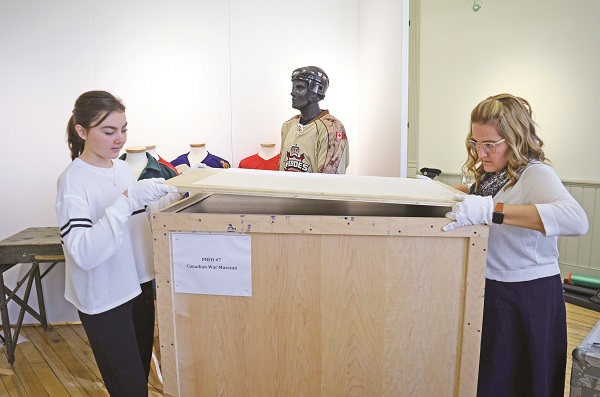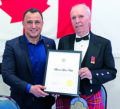General News » News
Play Hard, Fight Hard: Museum exhibition explores connections between military and sport
October 17, 2018 · 0 Comments

By Brock Weir
When Myrtle Cook was born in 1902, the modern-day Olympic games were just six years old, and when it came to track and field, women had yet to lace up and hit the ground running.
Miss Cook, however, was a pioneer and when women were finally allowed somewhat equal footing in the games in 1928, there was no holding her back.
As part of the “Matchless Six,” Myrtle brought home a gold medal and made a name for herself as a pioneer in women’s sports.
Her gold medal, along with her heavy-duty cleats are just two artefacts now on display at the Aurora Museum & Archives as they host Play Hard, Fight Hard: Sport and the Canadian Military.
Play Hard, Fight Hard: Sport and the Canadian Military is a travelling exhibition curated by Canada’s Sports Hall of Fame in partnership with a group of military museums from across Canada, including the Canadian War Museum, that explores the connection between sports and military service.
The exhibition was brought to Aurora in partnership with the Aurora Sports Hall of Fame, and local curators have been working hard to select from among hundreds of artifacts that arrived at the Church Street School earlier this month to tell a complete story.
Michell Johnston of the Aurora Museum and Archives gave The Auroran a sneak peak of the unpacking job, a process she described as “just like Christmas” for someone with such a passion for history.
“These are artefacts that help tell the Federal story,” she said. “We have items from four separate military museums, all telling different aspects of the Federal narrative.”
At the core of the exhibition is the intersection between sport and the military and how each helped define the other narrative.
“At the crux of it, it is strategy and teamwork,” she says. “People take sport very seriously, especially if you are a professional athlete, but it is a game at the end of the day and, in a lot of cases, it is a game that unites people through strategy and teamwork. Looking at the other side with the military, you have a group of people who are performing exercises that are based on teamwork and unfortunately, when the military is involved, it isn’t a game, it’s a matter of life and death.
“I think those two kinds of elements that sports and military have in common express a wide range of emotions and realities of the human condition. It is an interesting concept to put them together and to see how it is expressed with things that we see often, like a hockey stick, a mitt, and things we’re not necessarily exposed to like military artefacts, war diaries, logs and those kinds of things.”
Now, in the lead up to this Thursday’s opening, it is a matter of curating all of these objects and telling the story. The travelling exhibition includes hundreds of items, each inventoried and labelled A, B, and C. A items are artefacts that must be on display, B items are things that should go out, and those labelled C are nice-to-haves.
There is a little bit of wiggle room, allowing the Aurora Museum & Archives some “curatorial leeway” but importance is sometimes in the eye of the beholder. Ms. Johnson, for instance, says she’s particularly interested in a catcher’s mitt, and the story behind it, but it is a C item for which there might not be room.
Other artefacts venture close to the unusual with a invitation and harness from the Canadian Army in the Netherlands Tug of War Championship from 1945, and two replica firearms, one of which has an odd connection to Canadian football.
First shown in Alberta, Play Hard & Fight Hard has its Aurora debut this Thursday night, October 18, from 5.30 – 8.30 with a special reception that will include Bill Fleury, who will be speaking on the life of his ancestor, W.J. Fleury, who is a member of the Aurora Sports Hall of Fame for his contributions to cricket.
“As an Auroran, he highlights that convergence of being a part of the Queen’s York Rangers and that level of athletic excellence,” says Ms. Johnson. “As for this exhibit, we’re aren’t adding in elements of our own collection into the exhibit space proper. There are over 300 artefacts that came with the exhibition and our goal is to get as much of this out on display as possible and we want to showcase that local narrative with the people at the opening.”
For more on the museum, and the exhibition, which runs through January 23, visit www.auroramuseum.ca.











